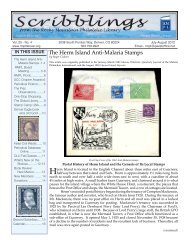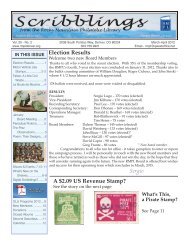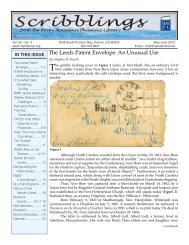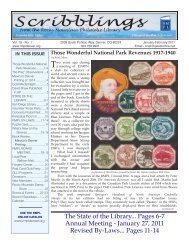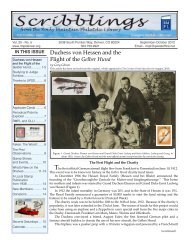Nov/Dec 2011 - Rocky Mountain Philatelic Library
Nov/Dec 2011 - Rocky Mountain Philatelic Library
Nov/Dec 2011 - Rocky Mountain Philatelic Library
Create successful ePaper yourself
Turn your PDF publications into a flip-book with our unique Google optimized e-Paper software.
By Roger Cichorz<br />
Last issue I showed “Dear Doctor” advertising postcards<br />
originating from the Burlingame Chemical Co. of Los<br />
Angeles. (Figures 1 & 2) They were posted in <strong>Nov</strong>ember,<br />
1908, addressed to Dr. U. S. Boone in St. Louis, Missouri,<br />
and had a printed advertising message for Pepso-Laxatone,<br />
a “digestant and tonic laxative” made by the Burlingame<br />
Chemical Co.<br />
Now just what was Pepso-Laxatone and what is the<br />
story behind it. Since 1908 was during the heyday of patent<br />
medicines, I decided to see what I could find out about<br />
Pepso-Laxatone. It only took me a few minutes of Internet<br />
searching to find enough information to write the following.<br />
According to Wikipedia, “patent medicine” refers<br />
to medical compounds of questionable effectiveness sold<br />
under a variety of names and labels. The term “patent<br />
medicine” is somewhat of a misnomer because, in most<br />
cases, although many of the products were trademarked,<br />
they were never patented. In fact, most avoided the patent<br />
process in order not to reveal the often hazardous and<br />
questionable ingredients of the products. In ancient times,<br />
such medicine was called nostrum remedium, Latin for “our<br />
remedy”!<br />
The promotion of patent medicines was one of the<br />
first major products highlighted by the advertising industry,<br />
and many advertising and sales techniques were pioneered<br />
by patent-medicine promoters. Patent medicine advertising<br />
often talked up exotic ingredients, even if their actual effects<br />
came from more prosaic drugs.<br />
In 1905, Samuel Hopkins Adams published an<br />
exposé titled The Great American Fraud in Collier’s Weekly<br />
that led to the passage of the first Pure Food and Drug Act<br />
in 1906. This statute did not ban the alcohol, narcotics,<br />
and stimulants in the medicines, but it required them to be<br />
labeled as such, and curbed some of the more misleading,<br />
overstated, or fraudulent claims that appeared on labels.<br />
In 1936 the statute was revised to ban them, and<br />
the United States entered a long period of ever more drastic<br />
reductions in the medications available unmediated by<br />
physicians and prescriptions. Morris Fishbein, editor of the<br />
Journal of the American Medical Association (JAMA), who was<br />
active in the first half of the 20th century, based much of his<br />
career on exposing quacks and driving them out of business.<br />
Returning to the story of Burlington Chemical Co.,<br />
what information did I find about Pepso-Laxatone? Simply<br />
stated, it qualified as a classic example of patent medicine –<br />
in fact, one whose claims of ingredients and efficiency as a<br />
digestive aid and laxative were exposed in 1920 by Federal<br />
chemical testing to be declared false and fraudulent. At<br />
that time a Mr. Hawley was president of the Burlingame<br />
Chemical Co. and he was also the owner-operator of two<br />
“Hawley Pharmacies” in Los Angeles.<br />
The Pepso-Laxatone label at that time, required by<br />
the Pure Food and Drug Act to reveal its ingredients, was<br />
illustrated in JAMA, Vol. 76, Jan.-June 1921, page 327<br />
(see Figure 3).<br />
Scribblings<br />
Variations of an Early “Dear Doctor” Postcard - Part 2<br />
What follows is the verbatim report cited in JAMA, one<br />
that no doubt gave Editor Fishbein great satisfaction in his<br />
ever diligent efforts to expose quackery in medicine: The<br />
Burlingame Chemical Co., Los Angeles, California, shipped<br />
in September, 1919, a quantity of Pepso-Laxatone which was<br />
adulterated and misbranded. When analyzed by the Bureau of<br />
Chemistry, it was found to consist essentially of alcohol, water,<br />
sugar, pepsin, and a laxative plant drug (presumably cascara<br />
sagrada).<br />
Figure 1<br />
Figure 2<br />
The label declared that Pepso-Laxatone contained<br />
pepsin (a digestive enzyme in gastric juice that breaks down<br />
protein to peptides), diastase (a soluble enzyme that converts<br />
starch and dextrin into sugar), and pancreatin (extract from<br />
the pancreas of animals that contains pancreatic enzymes).<br />
It contained neither diastase nor pancreatin and this claim<br />
was, therefore, declared false and misleading. Further,<br />
the product was claimed to be “an efficient combination<br />
of agents for the permanent relief of Gastric Disorders and<br />
Indigestion”: this claim was declared false and fraudulent.<br />
In February, 1920, judgment of condemnation and<br />
forfeiture was entered and the court ordered that the product<br />
be destroyed.<br />
Page 16 17 <strong>Nov</strong>ember-<strong>Dec</strong>ember <strong>2011</strong>



